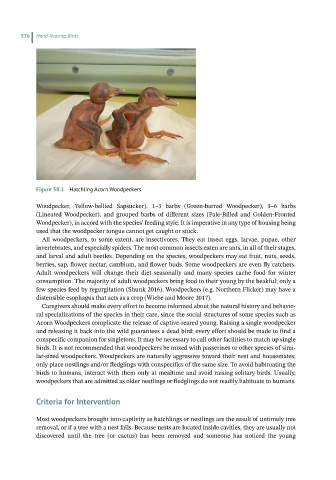Page 575 - Hand rearing birds second
P. 575
576 Hand-Rearing Birds
Figure 38.1 Hatchling Acorn Woodpeckers.
Woodpecker, Yellow‐bellied Sapsucker), 1–3 barbs (Green‐barred Woodpecker), 1–6 barbs
(Lineated Woodpecker), and grouped barbs of different sizes (Pale‐Billed and Golden‐Fronted
Woodpecker), in accord with the species’ feeding style. It is imperative in any type of housing being
used that the woodpecker tongue cannot get caught or stuck.
All woodpeckers, to some extent, are insectivores. They eat insect eggs, larvae, pupae, other
invertebrates, and especially spiders. The most common insects eaten are ants, in all of their stages,
and larval and adult beetles. Depending on the species, woodpeckers may eat fruit, nuts, seeds,
berries, sap, flower nectar, cambium, and flower buds. Some woodpeckers are even fly catchers.
Adult woodpeckers will change their diet seasonally and many species cache food for winter
consumption. The majority of adult woodpeckers bring food to their young by the beakful; only a
few species feed by regurgitation (Shunk 2016). Woodpeckers (e.g. Northern Flicker) may have a
distensible esophagus that acts as a crop (Wiebe and Moore 2017).
Caregivers should make every effort to become informed about the natural history and behavio-
ral specializations of the species in their care, since the social structures of some species such as
Acorn Woodpeckers complicate the release of captive‐reared young. Raising a single woodpecker
and releasing it back into the wild guarantees a dead bird; every effort should be made to find a
conspecific companion for singletons. It may be necessary to call other facilities to match up single
birds. It is not recommended that woodpeckers be mixed with passerines or other species of simi-
lar‐sized woodpeckers. Woodpeckers are naturally aggressive toward their nest and housemates;
only place nestlings and/or fledglings with conspecifics of the same size. To avoid habituating the
birds to humans, interact with them only at mealtime and avoid raising solitary birds. Usually,
woodpeckers that are admitted as older nestlings or fledglings do not readily habituate to humans.
Criteriafor Intervention
Most woodpeckers brought into captivity as hatchlings or nestlings are the result of untimely tree
removal, or if a tree with a nest falls. Because nests are located inside cavities, they are usually not
discovered until the tree (or cactus) has been removed and someone has noticed the young

